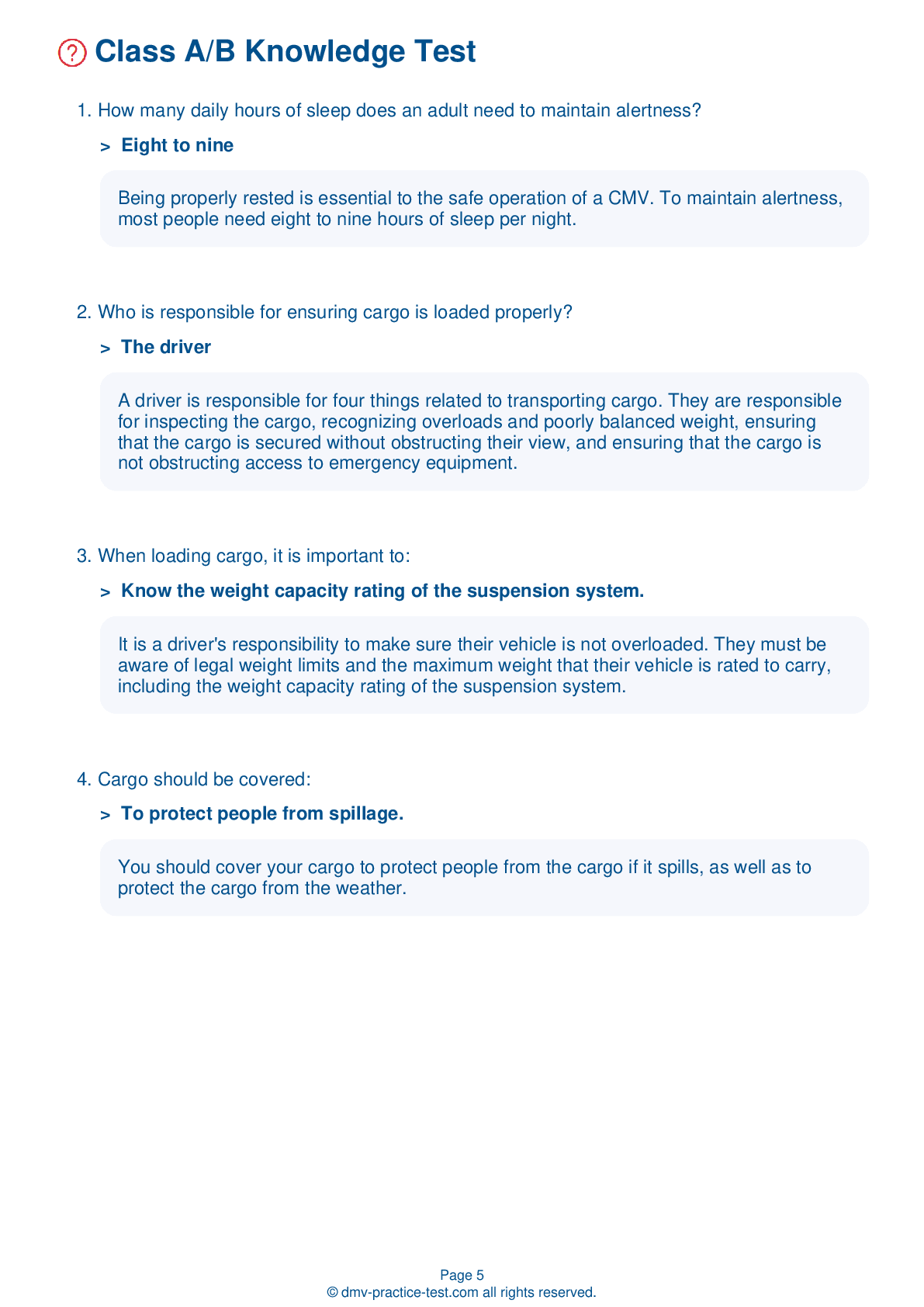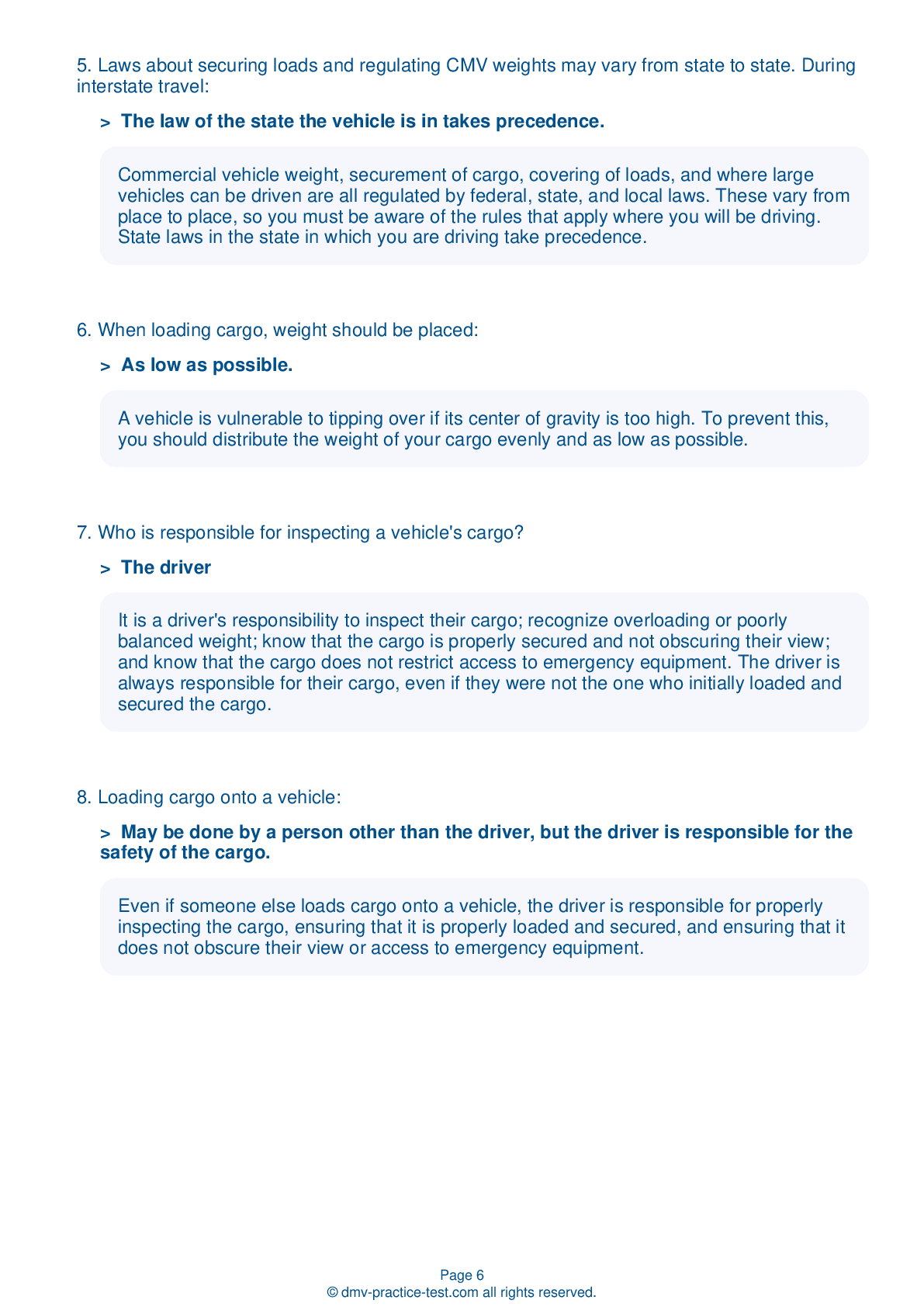FREE Online Bus Driver Testing | Connecticut 2024
Train for FREE online with our CT bus CDL test. The official exam test consists of several obligatory parts, with all of them checking your knowledge of different blocks of road rules. If you need to obtain a license in Connecticut in 2021, learn how to become a bus driver and then practice as much as possible. Free sample tests published on our website will help you check and improve your knowledge and boost your grades. Please bear in mind that DMV requirements for a bus driver may vary from state to state.
20
16
20
1 . When exiting a vehicle, a driver should:
When exiting your vehicle during the basic vehicle control skills test, you must face the vehicle and maintain three points of contact at all times. If your testing vehicle is a bus, you must maintain contact with the handrail. Exiting the vehicle incorrectly may result in automatic failure of the basic vehicle control skills test.
2 . During a basic vehicle control skills test, what is considered an encroachment?
The vehicle stalling while the driver shifts gears.
An encroachment during the basic vehicle control skills test is when an exercise boundary line is touched or crossed by any portion of the applicant's vehicle. Every encroachment will be counted as an error.
3 . When students board a bus, they should:
Students should not occupy the back row of a school bus unless the bus is full. The closer to the front of a bus that students are seated, the safer they will be in the event of a rear-end collision. Students with special needs should sit near the driver.
4 . During a basic vehicle control skills test, what is considered a look?
A driver glancing over their shoulder to check blind spots
A driver uses a look when they open their door, leave their seated position, and walk to the back of the vehicle to check its position. During the straight line backing exercise, a driver may not exceed one look. During any other exercise, a driver may not exceed two looks.
5 . When approaching a curve during the on-road driving test, you must do all of the following, except:
Steadily use the brakes throughout the curve.
When approaching a curve during the on-road driving test, you should thoroughly check traffic in all directions. Before entering the curve, reduce your speed sufficiently so that further braking or shifting is not required. Keep your vehicle in its lane and continue checking traffic in all directions.
6 . When inspecting engine compartment belts during the vehicle inspection test:
The applicant must identify which items are not belt-driven, if any.
When checking the engine compartment during the vehicle inspection test, you must check the power steering, water pump, alternator, and air compressor belts. In addition to cracks and frays, you should check the belts for snugness, allowing up to three-quarters of an inch of play at the center of each belt. If any of these items are not belt-driven, you must identify them and ensure that their components are operating properly, are not damaged or leaking, and are mounted securely.
7 . When checking the springs during a vehicle inspection, do all of the following, except:
Glue cracked leaf springs.
When checking the springs as part of the vehicle inspection test, you should look for missing, shifted, cracked, or broken leaf springs, as well as broken or distorted coil springs. If the vehicle is equipped with torsion bars, torque arms, or other types of suspension components, ensure that they are not damaged and are mounted securely.
2024 Connecticut | Frequently Asked Questions
A CDL Class B license in Connecticut allows you to operate single vehicles with a gross vehicle weight rating (GVWR) of 26,001 pounds or more, or any such vehicle towing a vehicle not exceeding 10,000 pounds GVWR. It includes vehicles like straight trucks, large buses, segmented buses, and trucks towing smaller vehicles.
A Class B CDL license in Connecticut enables the holder to operate single vehicles with a gross vehicle weight rating (GVWR) of 26,001 pounds or more, or tow a vehicle not exceeding 10,000 pounds GVWR. This includes straight trucks, large passenger buses, segmented buses, dump trucks with small trailers, and trucks towing smaller vehicles.
To acquire a Class B CDL license in Connecticut, you must be at least 21 years old (18-20 for intrastate driving), possess a valid Connecticut driver's license, pass a vision test, and successfully complete a knowledge test. After that, you must obtain a Commercial Learner's Permit (CLP), hold it for 14 days minimum, and pass a skills test.
In Connecticut, you must be at least 21 years old to qualify for a Class B CDL license for interstate transport. However, if you plan to drive only within the state (intrastate transport), you can qualify at 18 years old. It's important to note that additional requirements must also be met.
Specific endorsements are not necessary for a Class B CDL license, but they can expand your job opportunities. Endorsements certify additional skills like operating a school bus (S), passenger vehicle (P), or tank vehicle (N). You can also get an H endorsement for transporting hazardous materials. Each endorsement requires passing an additional knowledge test.
The Class B CDL skills assessment in Connecticut includes three parts: a pre-trip vehicle inspection test, a basic vehicle control test, and an on-road driving test. These tests assess your ability to inspect your vehicle, control the vehicle in various situations such as backing and turning, and safely operate the vehicle in traffic.
Yes, Class B CDL license holders in Connecticut are restricted to driving single vehicles with a gross vehicle weight rating (GVWR) of 26,001 or more pounds, or a towed vehicle not exceeding 10,000 pounds GVWR. They cannot drive a combination of vehicles (like a tractor-trailer) unless they have a Class A CDL. Additionally, they must comply with federal hours-of-service regulations.
Yes, the written Class B CDL test in Connecticut can be taken in languages other than English. The Connecticut Department of Motor Vehicles provides the test in several languages. However, federal regulations require that all CDL holders must be able to read and speak English sufficiently to converse with the general public, understand highway traffic signs and signals, respond to official inquiries, and make entries on reports and records.
Yes, you can request accommodations for the Class B CDL written exam in Connecticut if you have a disability. The Connecticut Department of Motor Vehicles complies with the Americans with Disabilities Act (ADA) and provides reasonable accommodations like extra time, a separate testing room, or use of special equipment. Be sure to make your request well in advance of your scheduled test date.
Yes, if you fail the Class B CDL written test in Connecticut, you can retake it. However, you must wait at least 7 days before retesting. There's also a retest fee that you'll need to pay each time you retake the test. It's recommended to study the manual thoroughly before retaking the test to increase your chances of passing.



